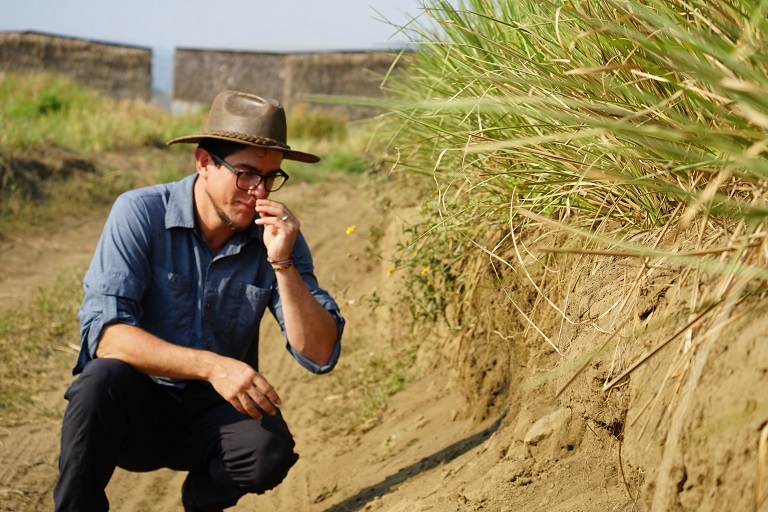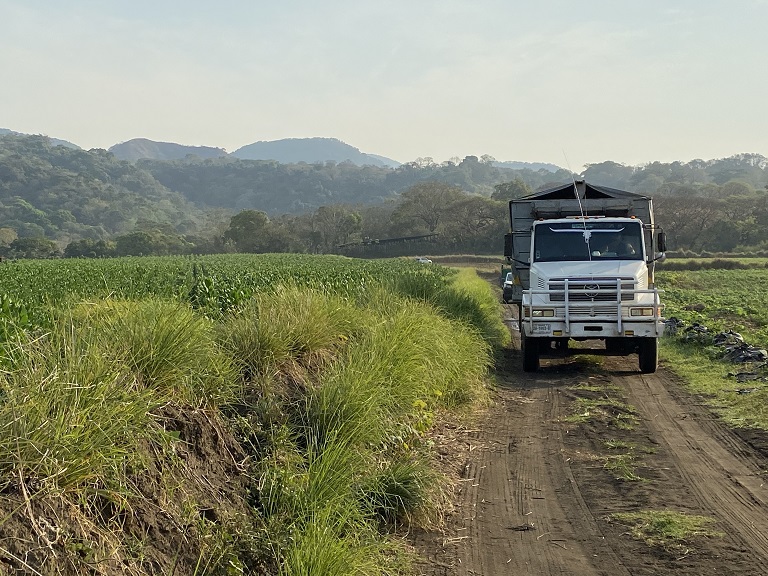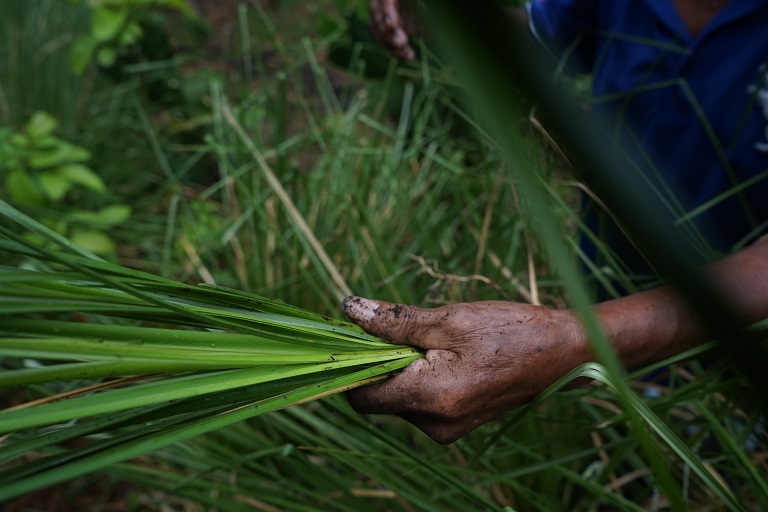- A longtime ingredient in fragrances, vetiver is becoming an ally for farmers facing the impacts of climate change.
- Planting vetiver grass in tropical and subtropical regions is a cheap and simple way to prevent soil erosion, capture carbon dioxide and detoxify the soil, with this nature-based solution already in use for decades in India and now becoming increasingly popular elsewhere.
- In Mexico, where 76% of the land suffers from erosion, one environmental expert in Veracruz state has become a pioneer in using vetiver to stop soil erosion.
- The method used on a tobacco farm helped reduce crop loss and improve harvests significantly in just its first year of implementation.
SAN ANDRES TUXTLA, Mexico — “There are not many regions in Mexico that have been used for agriculture for about 4,000 years,” says environmentalist Antonio Carrillo as he walks along a dusty dirt road. It’s early morning in the Matacapan Valley in the state of Veracruz.
The regular tropical rainfall and the fertile volcanic soil have made this valley surrounded by green hills an agricultural paradise. In the past, Indigenous people grew food crops here; after the Spanish conquest, sugarcane and cotton were introduced. In the 19th century, tobacco became the most important cash crop, and remains so today.
But like many other agricultural regions in Mexico, this fertile valley is threatened by climate change. Mexico’s rugged geography makes it particularly vulnerable to extreme events such as droughts and hurricanes, which are worsened by shifts in the climate. These further undermine the soil in the Matacapan Valley, which already suffers from erosion, as with most of the land in Mexico.
Carrillo stops abruptly and kneels down next to a dirt wall bordering the path. He points at a dense network of light-brown roots, similar to a ball of wool, crowned by long, narrow, light-green grassy leaves, with a rough surface and a longitudinal notch: Chrysopogon zizanioides, commonly known as vetiver. “We planted vetiver here just a year ago,” he says. “And the roots are already 2 meters [6 feet] deep!”

A seemingly random grass, vetiver could actually be a nature-based power tool against climate change: an elaborate system for mitigating erosion, sequestering carbon dioxide, cleansing overfertilized soils, and improving their natural fertility.
Originally from India, vetiver was cultivated during the colonial period mainly for use in the perfume industry. Essential oils in its roots form the earthy foundation of many fragrances. Other benefits of vetiver were forgotten, until the 1980s, when some states in India revived an ancient technique of growing vetiver hedgerows to combat the erosion of rice fields. It proved very successful. Vetiver was cheap, easy to handle, and effective. It doesn’t form seeds, reproducing only by root division, so its spread can be controlled, preventing an unchecked ecological invasion. Once planted, vetiver barriers last for decades. They’re particularly suitable for tropical and subtropical areas; the grass is drought-resistant and can tolerate floods and high soil salinity, but not tolerate prolonged ground frost or the herbicide glyphosate. The studies from India soon spread among farmers in Asia and finally across the world.

Carrillo, an agricultural expert and director of the Mexican consulting company Estampa Verde, first heard about the grass in 2005 at an agroecology workshop at Las Cañadas, a permaculture center in Veracruz.
“I took a few bunches and planted them on our family property,” the 41-year-old says. That property was a former cattle ranch on steep hills surrounding the Sontecomapan Lagoon, which his father-in-law had bought to reforest the area and open an eco-hotel. But the poor, eroded soil and intermittent heavy storms and rainfall made the project difficult. After Carrillo’s vegetable garden was washed away by a tropical storm, he planted vetiver around it.
The garden survived the next storm. He then planted vetiver in terraces across the hill — and quickly saw the results: “The erosion was stopped, the trees sprouted behind the barrier, and the leafcutter ants didn’t like the vetiver either and migrated,” he says.
The vetiver grass is regularly trimmed, creating organic material that further enriches the soil. Vetiver is also a biological means of cleaning up soil and water contaminated by heavy metals, studies have shown. Part of the family of C4 plants, the rapid-growing vetiver is highly effective in creating biomass and absorbing carbon dioxide. In Asia, the grass is also used to make handicrafts and briquettes for burning or building.

Over the years, vetiver barriers have shaped the landscape and formed terraces — similar to what the Inca people in the Andes did in the past. The only difference is that the Incas had to work very hard, carrying heavy stones, to build their ramparts. Vetiver barriers are much easier to implement. In Andean countries such as Ecuador, Venezuela and Colombia, vetiver has therefore been planted for some time. But not in Mexico. Carrillo wants to change that.
He started to offer it to clients of Estampa Verde. The first trial started in 2014 on a sugarcane plantation. Shifting from the few hectares of his family farm to the nearly 50 hectares (120 acres) of the plantation was an ambitious leap. Carrillo made some drafts with different designs.
“Combined with the keyline design, which originated in Australia, the results were the best,” Carrillo says. Keyline design is a land management practice that uses the natural ridges and contours of a property’s topography to slow down, spread and absorb rainwater.

A combination of vetiver barriers and a redesign of planting and infrastructure patterns helps to prevent water erosion during heavy rainfalls, common in the tropics. In 2019, Carrillo began working with Tabacalera Alberto Turrent a family-owned tobacco company based in San Andrés Tuxtla in the Matacapan Valley. It controls 374 hectares (924 acres) of land in the region, some of them its own fields, the others leased out.
“In some years, we’ve had total losses of some fields due to heavy rains,” says owner Miguel Turrent in his small, windowless office, right next to the warehouse with the ready-to-ship cigars that are exported around the world. So he turned to Estampa Verde for help.
The consultants used drones to map the fields and came up with a new design. Paths had to be redrawn, and the tobacco fields laid out in wavy lines, interspersed with vetiver barriers. “I was very skeptical at first,” Turrent says. “And it wasn’t easy to convince my workers and engineers to change their conceptions and working methods.”

But the results were clear in the first year, he says: “A field where I previously harvested 1,000 kilograms of tobacco per hectare” — about 900 pounds per acre — “was already yielding 1,700 kilograms [1,500 lbs per acre] by 2020. Vetiver has done a miracle,” the agile 50-year-old businessman tells Mongabay.
However, it’s not a panacea on its own. Crop rotation or anticipating or delaying planting to adapt to changing climate patterns are also necessary to prevent losses, Turrent adds. But for him, the experiment has paid off, and the region is benefiting as well: Besides the local government, the tobacco industry is the most important employer in the Tuxtlas. Turrent alone employs 600 permanent workers, plus up to 600 temporary workers per day during the harvest period. Around 7,000 families in the region live off the tobacco industry.
But for Carrillo, the work is not done yet. He sees himself more as an environmentalist than an agronomist. That’s why Estampa Verde has set up artificial beehives for native Melipona bees in the forests surrounding the tobacco fields to study the impacts on their population. “Bees are indicators of the ecological health of an area,” he says. “They are sensitive to changes such as more or less pesticide use.” The bee study has not yet yielded conclusive results, but some of the collection sites are already hosting bee colonies.

Carrillo has systematized his work on the tobacco farm and on the sugarcane plantation, and summarized the results in a study. His paper, titled “Climate Risk Reduction and Soil Conservation Tool for Agriculture: Keyline Vetiver Hedges Minimum Standard V.1.3,” won this a King of Thailand vetiver award. Carrillo feels that this could help to attract more attention and investments into vetiver as a climate tool.
Currently, there are only a few mainly smallholder farms and cooperatives, mostly in the states of Oaxaca, Veracruz and Chiapas, that know and use the method. The plants are mostly passed from farmer to farmer. Commercial cultivation of vetiver is hardly widespread; even the government and agricultural universities don’t yet have the method on their radar.
One of the pioneers is small-scale farmer Marco Gutiérrez. He runs a family farm of 10 hectares (25 acres), barely half an hour above the tobacco factory on the steep mountain slopes. The virgin forest there was cleared by his father 20 years ago to create a cattle ranch. Gutiérrez wants to turn back time and convert it into agroforestry. His most persistent opponent is the palisade signal grass (Brachiaria brizantha). It was hyped as cattle feed 20 years ago, but it’s a brutal colonizer that withers trees and is nearly impossible to eradicate. “I tried to rip it out by digging around it and sprayed with glyphosate,” Gutiérrez says. “Nothing helped.”

Only after he immediately planted vetiver in the dug-up soil and put trees behind were they able to grow. He’s also planted vetiver on a hill to help fix his banana plantation, and says he’s content: “Vetiver is a great plant that helps the other plants grow,” says the 40-year-old, who has also used vetiver to reduce erosion along the slippery clay trails on his property.
Carrillo looks at the banana plantation with satisfaction. “The method works in very different contexts, is relatively easy to apply and produces rapid results,” he says. The luxury version, though, which includes drone mapping and digitization, isn’t available for everybody: it costs around 20,000 pesos ($1,100) per hectare, or about $450 per acre. But small farmers can also achieve good results with a simple site inspection and a hand-drawn map.
The use of vetiver as a nature-based solution for climate change-related problems isn’t limited to agriculture. Carrillo points out that the grass can also be useful for building public infrastructure that’s vulnerable to erosion, from roads to dams, or for preventing natural disasters such as landslides in poorer neighborhoods.

In Mexico, vetiver still isn’t widely used or studied. Carrillo has already made several attempts to get scientists on board, but the COVID-19 pandemic, funding cuts for research by the current government, and a complex bureaucracy have so far frustrated his attempts. Despite its overall merits, Carrillo doesn’t see vetiver as the ultimate solution.
“For me, vetiver is a very good first step in a transition toward more complex ecological farming systems,” he says, referring to permaculture and agroforestry. Both systems were very common before the Spanish conquest, but then lost ground to industrial monocultures for export.
Carrillo says he believes the ecological farming systems of the Mexican ancestors should be revitalized, because they contribute to healthier and more resilient food systems. But transition isn’t easy. Reconverting a conventional farm into more sustainable agriculture takes several years and a completely new mindset. For many farmers, vetiver could be the first step into this new world of agriculture.
Citation:
Bhatia, K., Baker, A., Yang, W., Vecchi, G., Knutson, T., Murakami, H., … Whitlock, C. (2022). A potential explanation for the global increase in tropical cyclone rapid intensification. Nature Communications, 13(1), 6626. doi:10.1038/s41467-022-34321-6
Banner image: Vetiver keyline. Image courtesy of Estampa Verde.
Related reading:
Regenerative agriculture in Mexico boosts yields while restoring nature
Investors say agroforestry isn’t just climate friendly — it’s also profitable
FEEDBACK: Use this form to send a message to the author of this post. If you want to post a public comment, you can do that at the bottom of the page.














